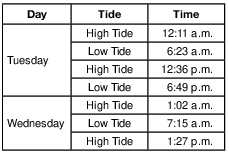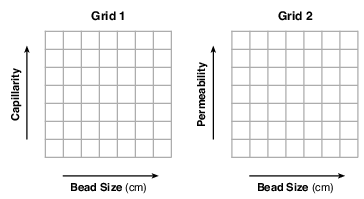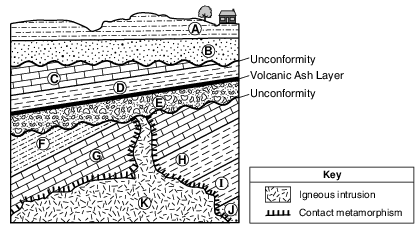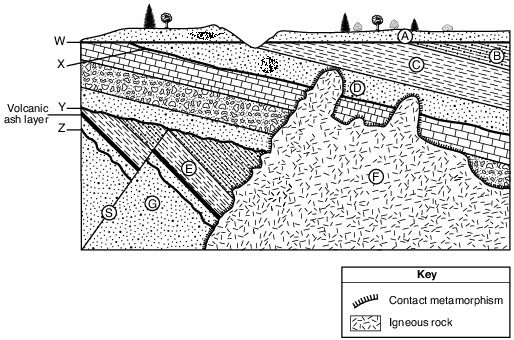Topic: Test Sediment Properties And The Rate Of Deposition
Test Sediment Properties And The Rate Of Deposition
Compared to the terrestrial planets, the Jovian planets are
(1) larger and less dense
(2) smaller and more dense
(3) closer to the Sun and less rocky
(4) farther from the Sun and more rocky
The cross sections below represent three beakers that were used to test porosity. Beakers A, B, and C each contain a different size of bead. Each beaker holds an equal volume of beads. The amount of water needed to fill the total pore space between the beads in each beaker was measured.

Which statement best describes the porosity that was found for these three samples?
(1) A had a greater porosity than B and C.
(2) B had a greater porosity than A and C.
(3) C had a greater porosity than A and B.
(4) All three samples had the same porosity.
Sediment samples A through D below have the same volume and packing, but contain different percentages of various particle sizes.
Sample A: 75% clay and 25% silt Sample B: 25% clay and 75% sand Sample C: 50% pebbles and 50% sand Sample D: 50% pebbles and 50% cobbles
Which sample most likely has the greatest permeability?
(1) A
(2) B
(3) C
(4) D
The cross section below represents prevailing winds moving over a coastal mountain range. Letters A through D represent locations on Earth’s surface.

Which location will most likely have the least annual precipitation?
(1) A
(2) B
(3) C
(4) D
The table below shows tide data for a location on the north shore of Long Island, in New York State.

Based on these data, what is the most likely time of the next high tide?
(1) 1:53 a.m.
(2) 1:53 p.m.
(3) 7:40 a.m.
(4) 7:40 p.m.

Draw a line on grid 1 in the image below to show the general relationship between bead size and capillarity. Draw a line on grid 2 in the image provided to show the general relationship between bead size and permeability. [1]

Allow 1 credit for grid 1 showing an inverse relationship, and grid 2 showing a direct relationship.
• Example of a 1-credit response:
• 

The top of the box in the image provided represents the stream surface between points A and B. In the box, draw a line from point A to point B to represent a cross-sectional view of the shape of the bottom of the stream channel. [1]

Allow 1 credit if the student’s line is drawn from point A to point B and shows that the stream channel is deeper near side A.
• Example of a 1-credit response:
• 

Describe how the size and shape of sediments will most likely change as they are transported downstream. [1]
Size: Shape:
Allow 1 credit for two correct responses. Acceptable responses include, but are not limited to:
• Size:
• — becomes smaller
• — decrease
• Shape:
• — becomes more rounded
• — less angular
• — Sharp edges are worn down.
• Note: Do not accept “smooth” for the shape of the sediments, because smooth does not describe
• a shape but a texture.
Gold Mining
A sluice box is used to remove gold pieces from other sediments in a stream. The box is placed in the stream to channel some of the water flow. Gold-bearing sediment is placed at the upper end of the box. The riffles in the bottom of the box are designed and positioned to create disruptions in the water flow. These disruptions cause dead zones in the current that allow the more dense gold to drop out of suspension and be deposited behind the riffles. Lighter material flows out of the box as tailings. Typically, particles of the mineral pyrite, which shares characteristics with gold, are deposited with gold particles in the sluice box. Since miners were fooled into thinking the nuggets of pyrite were gold, the name “fool’s gold” is often applied to pyrite.



Identify the characteristic of gold shown in the table that allows gold to be deposited behind the riffles, while other material flows out of the sluice box as tailings. [1]
Allow 1 credit for density or high density or 19.3 g/cm3.

List the letters E, H, and K to indicate the correct order of rock unit formation, from oldest to youngest, that formed this portion of Earth’s crust. [1]
Letters: ___________, ___________,___________ Oldest --> Youngest
Allow 1 credit for the sequence shown below:
• 

In the blanks in the image provided, place the letters E, F, G, S, and Z in the correct order to represent the relative ages of these rock units and features, from oldest to youngest. [1]

Allow 1 credit for the correct order shown below:
• 
